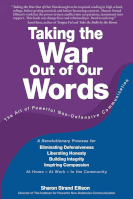 |
Full Title: | Taking the War Out of Our Words The Art of Powerful Non-Defensive Communication |
|---|---|---|
| Author(s): | Sharon Strand Ellison | |
| Publishing / Edition: | Voices of Integrity, 2016 |
 |
Full Title: | Taking the War Out of Our Words The Art of Powerful Non-Defensive Communication |
|---|---|---|
| Author(s): | Sharon Strand Ellison | |
| Publishing / Edition: | Voices of Integrity, 2016 |
| Option In War | Defensive Reaction [Personality Type] |
Description |
|---|---|---|
| (Counter)attack | Justify [Defensive] | Responding to criticism by explaining your own behavior or making excuses |
| Blame [Aggressive] | Attacking the other person's position in an attempt to defend yourself | |
| Withdraw | Escape [Passive] | Avoiding talking about something you don't want to discuss in order to avoid conflict |
| Entrap [Vindictive] | Refusing to respond to someone in order to draw that person into a situation where they may feel uncomfortable or act inappropriately | |
| Surrender | Betray [Co-Dependent] | Giving in to someone who treats you poorly, blaming yourself, and making excuses for the person |
| Sabotage [Passive-Aggressive] | Pretending to agree with someone who you think is treating you poorly and then doing something to undermine the person |
| Nature: | Curious, open, innocent, neutral, inviting |
|---|---|
| Function: | To gather information |
| Nature: | Open, vulnerable, direct, subjective, descriptive |
|---|---|
| Function: | To provide information |
| Nature: | Protective, foretelling, neutral, definitive, firm, dual in nature |
|---|---|
| Function: | To provide security through predictability |
| Separateness: | Each person is able to maintain the clarity of his or her own position instead of getting caught in power struggle |
|---|---|
| Disarming: | Each person is likely to respond with openness and sincerity |
| Clarification: | Each person has an opportunity to affirm, deny, or qualify a position |
| Accountability: | Each person is accountable for what he or she says and does |
| Quantum Leaps: | Each person has the opportunity to take quantum leaps in personal growth |